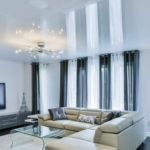Fabric stretch ceilings
Fabric stretch ceilings appeared in the arsenal of installers not so long ago. Just a couple of decades ago, the world knew only about film canvases.
The fabric base is a mesh material, impregnated with polyurethane on both sides. Due to the fact that the mesh is very fine, the panel appears solid and impenetrable.
I will talk about the pros and cons of fabric ceilings, as well as types of panels.

The content of the article
Photos of fabric stretch ceilings
Despite the name “fabric”, the canvases are made from synthetic polyester. It is pulled into a thin thread and they spin it into cloth. This material is subsequently used to make canvases for hanging structures.
This type of finishing is much more expensive than film analogues. But the high cost is justified by a number of advantages.
I note that the appearance of the fabric ceiling fully lives up to its name. At first glance it is difficult to determine the type of material. It really looks like real fabric. In addition, the fastening system of the structure differs from the installation of film materials.



Fabric stretch ceiling
Now let's look at the main points regarding this material. Let's study the structure and production scheme. Let's find out what surrounds us in apartments and how does it affect our health.
Material structure and composition
Polyester natural fabric is no different in appearance from ordinary woven fabric. It has weaving - strong and reliable. For added durability and even water resistance the material is impregnated on both sides. This makes it leak-resistant, strong and durable, and also gives it elasticity.
The main competitors in the global stretch ceilings market for the production of fabric fabrics are Descor and Clipso.

Installation Features
Fabric sheets are attached to the ceiling in a special baguette or on a frame. The peculiarity of installation is that there is no need for a heat gun, as is the case with film materials.
The fabric is often produced in one piece, without welds. Its width is large enough to completely cover the ceiling in a large room. For large rooms, several panels are sometimes welded. In this case, it is better to cover the seam with a decorative element, such as a beam or plinth.

Pros and cons of the design
Fabric fabrics have a number of features and advantages that film structures cannot boast of. The main advantages include:
- Attractive appearance thanks to the unusual texture.
- Possibility of painting up to 4 times.
- Durability and long service life due to the introduction of modern technologies into production.
- Resistance to temperature fluctuations (from -40˚С to +80˚С).
- Safety. The material does not emit caustic chemical elements hazardous to humans. It also does not burn and does not accumulate static electricity.
- Easy to install, no additional equipment required.
- Good insulating properties.
No need for exact measurements of the room. The material is brought to the site with a reserve, and then the excess is cut off.
Despite all the advantages of the design, fabric ceilings also have disadvantages:
- Presence of synthetics. The material consists almost entirely of polyester, so it can hardly be called completely environmentally friendly.
- Lack of flood resistance. We all know how film ceilings hold water when flooded by neighbors above. Fabric ones can last no more than a couple of hours - then water will seep into the room.
- Lack of breathability. Due to impregnation on both sides, the fabric practically does not allow air to pass through.
- High price. Installation companies, as a rule, set a price twice as high as film ceilings.
- Poor choice. The catalog contains no more than 20 shades and several textures. But in fairness, it is worth noting that these textures and shades are very expressive.
Having considered all the advantages and disadvantages of the design, you can decide for yourself whether you are ready to overpay for this type of ceiling. Its beauty is undeniable - the appearance resembles real fabric. But, unfortunately, the composition of the material is far from environmentally friendly.

Types of fabric ceilings
In addition to several dozen shades of fabric, you can find varieties of material in the catalogs. They are distinguished by texture and composition. Each variety deserves a separate description. Let's consider the main ones:
- Textured. The effect of a voluminous fabric is achieved by placing two layers of fabric on top of each other. The first of them is a fine mesh. The second one is denser and has embossing.
- Satin. A pleasant material with a fine-grained structure that allows you to visually increase the height of the room. The mother-of-pearl effect with well-chosen lighting gives the ceiling an original appearance.
- Calico.The chic effect of this material is explained by its transparency. Built-in or under-material lights add a mysterious sparkle and give the room a pleasant glow.
- Suede. This fabric is similar to natural suede in appearance and effect on the room. The ceiling looks expensive and dims the light. This design looks appropriate in the strict classical interiors of men’s offices or living rooms in large houses.
The texture of the fabric ceiling is important for creating the interior of the room. For example, suede or textured fabrics are more suitable for classic ones. Modern design can be easily supported with satin or chintz ceilings.





